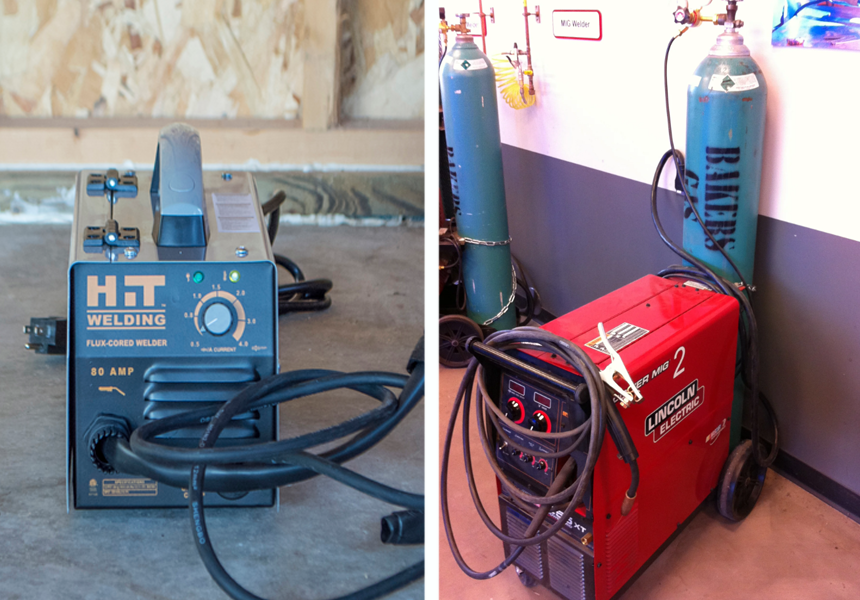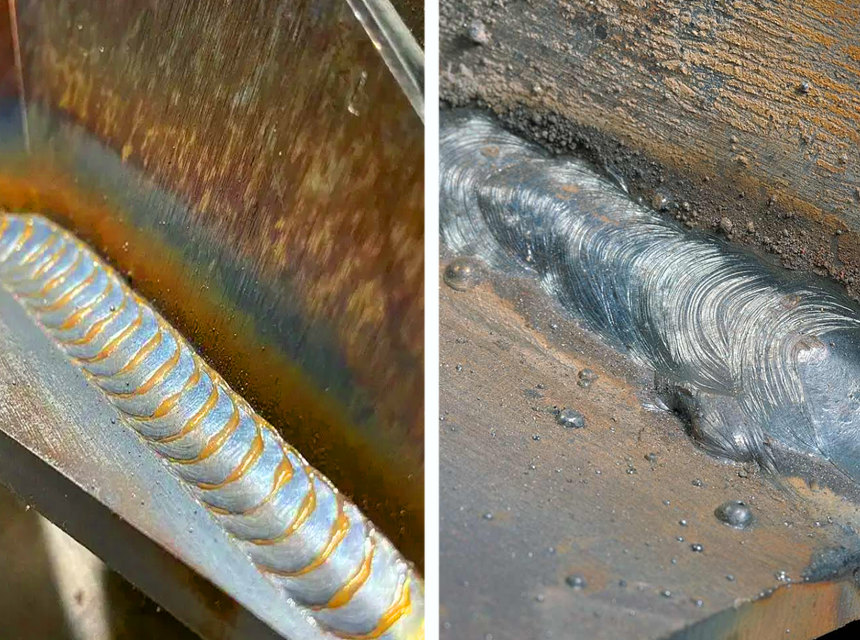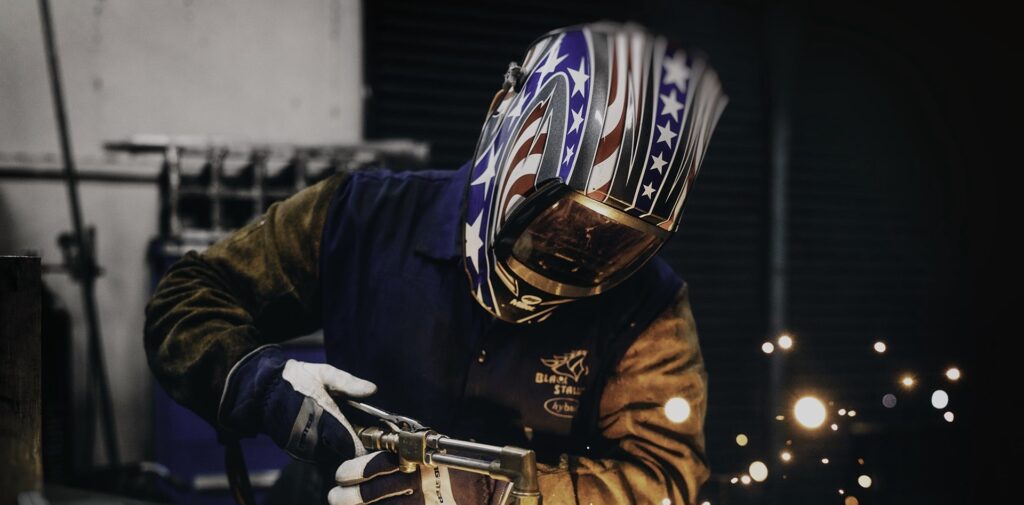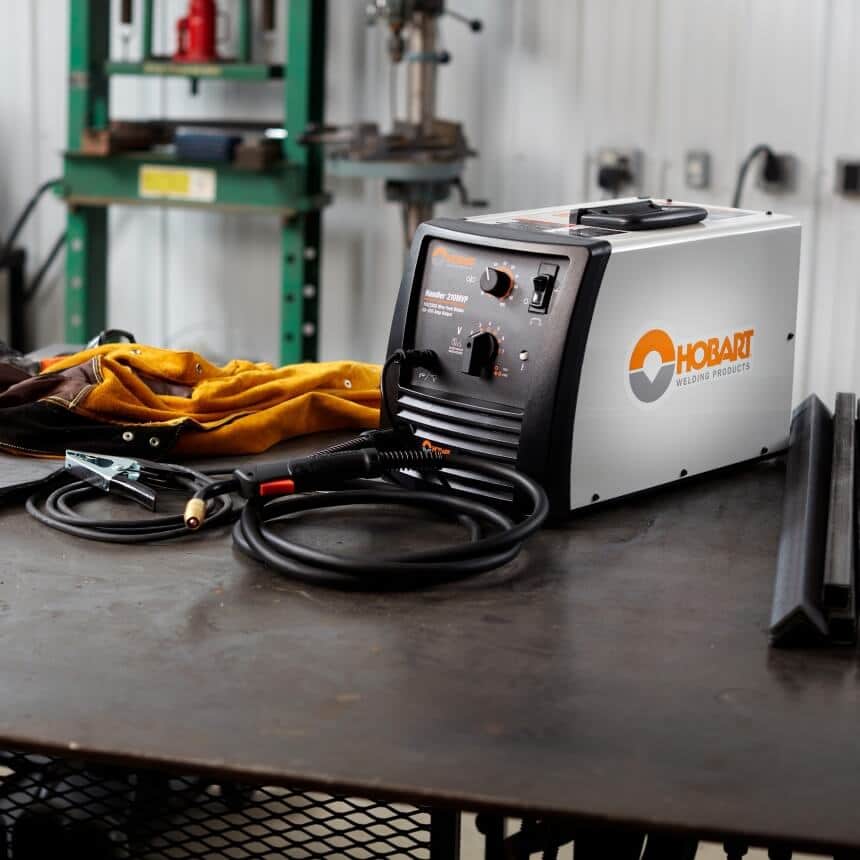Welding is an integral part of construction and fabrication, and experts know that a good welding task must be done right. There’s often debate on flux core vs. MIG welding and which is best for getting the job done. While it can be confusing, the first step is to determine the pros and cons of each type and determine which is the best to get the results you need.
This article will break down all the aspects of MIG and flux core welders, their key strengths and weaknesses, and compare and contrast them. People often ask which is ‘better,’ and in this article, we’ll show the answer is simply that it depends on your needs.
Here is a quick overview of the different aspects of welding and a side-by-side comparison of both products.
 In general, flux core welders are easy to move around, as they do not require a gas tank which can be very cumbersome. MIG welding work always requires a gas tank and multiple gas tanks, making maneuverability very difficult.
In general, flux core welders are easy to move around, as they do not require a gas tank which can be very cumbersome. MIG welding work always requires a gas tank and multiple gas tanks, making maneuverability very difficult.In terms of types of material, flux core welding is best for:
MIG welding is best for:
Below, we’ll go deeper into detail about flux core welding vs. MIG welding and the pros, cons, similarities, and differences between them. Comparing the two will reveal that, while the two have many similarities, some jobs definitely work better with one or the other.
While it might seem easier just to find the best multipurpose welder and be done with it, this isn’t always the most practical (or affordable!) option. That’s why it’s important to break down the differences between the types of welding needed, starting with flux core wire vs. MIG wire. It’s also good to note that many MIG welders can also use flux core wire.
An interesting point about flux core vs. MIG wire is that some MIG machines can use both (though not the other way around) because they work very similarly in many ways. Both types of welding rely on a wire spool fed through the torch, making them much easier to use continuously than stick welding processes. The wires transfer the current and support the weld while simultaneously giving the material you need to fill the weld properly.
However, there are some significant differences which we’ll look at in detail below.
Flux core wire is more or less hollow – a straw-like tube with flux and some other materials in its core. A big difference in flux core wire vs MIG is that flux core wire can become very specialized: the right internal compounds might differ between projects, so you may need more than one flux wire depending on the job.
The alloy in the flux core is usually not an exact match to what is being welded. Some are best for single-pass jobs, while others are able to handle multi-pass jobs. An example of this is that you will find flux core wires that are high in a specific metal that should be used for a particular weld.,
They are also sensitive to moisture and heat, so they must be stored properly in dry, cool places.
Though MIG solid wire vs. flux core sound like they would produce very different results, this isn’t always true. The strength of the weld is usually very similar when performed correctly with either type of wire. However, when it comes to casting iron, you’d be better off finding the best flux core welder to get the job done, as the welds are stronger in this case. However, it won’t work on aluminum.
In terms of penetration, the focused heat in the electrode means that you get better penetration per amp with the flux-cored wire, offering a little extra penetration for thicker pieces of work. Also, while MIG welding requires a gas tank, a home device like the VIVOHOME Portable 130 doesn’t require gas.
Though it is more sensitive in storage, flux core wire is robust in windy outdoor conditions and does well even through paint or rust. It’s also cheaper.
As its name suggests, MIG wire is solid, and the same wire can be much more versatile than the flux core method, which requires several different wires for different jobs. Therefore, the filler material from a MIG weld is purer, easier to work with, and easy to pass multiple times if needed. As a bonus, the alloy used and the material you are welding is often the same.
As mentioned before, when both are done correctly, there is no significant difference in flux core vs MIG strength of the weld. All good welding machines, like the Hobart Handler 140, are specifically designed to be easy to use in the right way and create a strong, firm weld.
Though you can get an extra nudge of penetration from a flux core weld for the same amp level, the general penetration level of a MIG weld is also pretty good, though it does require more energy.
In general, MIG wire produces a cleaner weld and less unruliness in work. It’s also great for jobs with thin metal and exceeds aluminum work. However, even though it’s possible to work with cast iron or thick stock, even the best MIG welder can’t match up to the flux core for these specific materials.
Flux core welding vs MIG is never as simple as “this works better than that.” After all, there’s a reason that both types exist in the first place! Some of the major similarities include:
When choosing between a MIG vs. flux core welder, your focus will be on the differences rather than the similarities. Make sure you know your requirements for each one before making a decision! Below, we’ve broken down some of the need-to-know bits and pieces about a weld where the differences between the two become important.
MIG welding requires a gas tank: flux core vs gas is a real dilemma! MIG actually stands for metal inert gas. During a MIG weld, the gas protects the weld from the other gases in the air, preventing them from interfering with the smoothness of the weld.
The main gases used in MIG welding are carbon dioxide, argon, an argon and carbon dioxide compound, or tri-mix, a combination of all three used mostly for welding stainless steel. Other gases used in gas metal arc welding include oxygen and helium.
Since flux core welds do not require gas, they must battle air contaminants differently and do so through their hollow core. The flux creates its own shield gas as it is being used alongside a crust of slag to protect the weld. Some flux wires do use gas tanks for extra protection, but self-shielding is the more usual type. Those that do use a gas tank for extra protection are called double-shielded flux core welders.
The two types are called electronic arc welding and gas metal arc welding. Trusted Source www.epa.govMIG offers more control to the user as by changing the gas tank, you can easily change the shield gas it generates to suit the metal you are going to use. However, it is much less flexible thanks to needing at least one heavy gas tank plus accessories in order to operate.
Flux-cored welding offers more mobility since it doesn’t require gas tanks but requires more specialized materials, such as different types of wire, stored properly for different kinds of weld jobs.
The flux-cored wire is structured as a hollow metal sheath around a core made up of slag formers, alloy materials, and flux, all of which require cool, dry storage to prevent damage. You need different types of flux core wire for different jobs.
MIG wire is a solid tube of a given metal without reliance on a separate core and is much more versatile.
In MIG welding, the work produced is negatively charged while the torch electrode is positively charged, meaning the current comes FROM the torch. This is called direct current, electrode positive (DCEP) work, and the heat is concentrated in the welded material. It’s also sometimes known as reverse polarity.
Flux core welds have a negative electrode and a positive workpiece, meaning the current goes TO the torch. However, some flux core wires actually use DCEP, so make sure to check! This is known as direct current, electrode negative (DCEN), or just polarity.
On a practical level, the differences aren’t all that easy to see in the filler material from flux and MIG wires, but there is actually an important distinction. The additives in the core of a flux core wire are specific to the kinds of metal they should be used with, and the slag creates a bead that is similar, but not exactly the same, as the welded metal. Many grades of flux core wire are also only good for single passes.
With MIG wires, the alloy is very often the same as the welded metal and is much more solid for multiple passes and versatile use.
When used correctly, both MIG and flux core wire welds produce welds of similar strengths. However, MIG produces much weaker work when used on cast iron and is weaker with thicker stock. Conversely, flux core wires are unsuitable for good-level aluminum work.
Many welders will argue for one or the other of these methods in terms of a good strong finish, but the truth is that the resulting weld is usually comparatively the same for both on almost all metals.
On a base level, both MIG and flux core welds produce good penetration. However, flux core welding uses focused heat, which is better for penetrating thick metals and getting more penetration from the amount of power used.
As we’ve discussed, both types of welding methods have many pros and cons. The sections below will look a little more closely into various steps of the welding process and how each method performs in that area.
The most important thing to remember is that the method chosen should be the method best for the job you need. To help you find that out, here are some tips.
MIG beads do not react well when faced with any sort of debris in their welding path. The surface for a perfect weld should be shiny bright white metal, and this is an important part of preparation. If the surface has paint, rust, or dirt or is otherwise ill-prepared, you’re unlikely to get the best out of your MIG weld.
When the base metal is bound to have dirt, rust, paint, or other debris, a flux core is best to use – for example, if you’re working with scrap metal at a junkyard or shipyard, which is unlikely to be easy to clean completely. Not only can it work through them, but it can also remove oxides and dirt as it goes.
MIG welds have a reputation (and a well-deserved one at that!) for attractive, clean welds. They don’t produce much splatter as they work, and the result is usually fairly neat.
As part of the process of creating their own gas shield, flux core wires produce slag, and that slag spatters and, yes, gets messy. It’s not the go-to option for aesthetic welding.
If you want to MIG weld outside, you need to be in almost-perfect conditions with winds of less than five miles per hour – in other words, MIG welding isn’t practical outdoors at all. If the wind gets any higher than that, the shielding gas will disperse, and the weld will be ruined.
While nobody is suggesting that you weld in a hurricane, a flux core wire can withstand much more of what the elements offer. When welding outdoors, the slag crust protects the flux wire from the wind right up until they reach around thirty-five miles per hour.
Car parts, sheet metal, and other thin parts are best welded using gas metal arc welding (GMAW), and MIG welding is one of these processes. The MIG wire is much less likely to cause burns throughout your material, and the clean weld also makes the stock easier to paint or leave the welded corners as decorative. It can be used as low as 24-gauge sheet metal.
However, while MIG welding can work on thicker stock, it requires a lot more power and only ever produces an acceptable, rather than excellent, result.
Flux core wire shouldn’t be used on materials thinner than an eighth of an inch. The intensity of the heat from flux core work (or flux core arc welding, FCAW) is simply not suitable for thin stock material, as it is likely to burn through your workpiece and ruin it. The spatter also makes it not useful for materials that require decoration, such as car parts, since the paint is less likely to be able to bond.
With thick stock, flux core wire has much better penetration and produces excellent quality welds up to around three-eighths of an inch in thickness.
Per pound, the flux core wire is more expensive than the MIG wire to buy. However, in terms of overall cost, flux welding is actually the cheaper option. This is because MIG welding also includes gas tank prices, more amps, and a more expensive welder. Prices vary depending on the job and machine used, but flux core welding is a cheaper option overall.
MIG wire isn’t useful for cast iron. MIG welding can work on cast iron with enough power, but the result will always be weaker than desirable and otherwise inferior. For cast iron welding, flux core welds are a much better choice. They offer deeper penetration and more lasting strength for the cast iron weld.
Technically, both flux core and MIG can be used for aluminum, but practically speaking, this isn’t the case. Apart from the issue of slag interfering with any aluminum weld since the weld is usually left open to the elements – already making the low-spatter MIG weld the better choice – a spool gun/wire-feed welder is the best way to weld aluminum.
Flux core wires which work in this way aren’t real; the closest thing is a wire-feed welder used for brazing. Sometimes, solid aluminum wires are mis-sold as flux core wires, but this isn’t the case.
As such, MIG is the only real option for good-quality aluminum work.
If you need to weld galvanized steel, it can be quite daunting to think of the amount of preparation you’ll need beforehand, as, of course, you need to get rid of the galvanization first! This usually means a lot of grinding of material to create a space you can weld through, which makes MIG welding and its requirements for a pristine surface a less-than-ideal choice.
Flux core work, though, can burn through the galvanizing all by itself as part of the process and result in a strong weld without any further difficulty. This makes flux core the clear choice when working with galvanized steel.
MIG and flux core welding are two of the more commonly used welding methods in the construction industry, but of course, others are used in various ways. These types of welding are not as directly comparable as MIG and flux core welding, but it’s still important to know if you want a rounded knowledge of welding techniques.
There are four main overarching types of welding: Gas Metal Arc Welding (GMAW or MIG welding), Gas Tungsten Arc Welding (GTAW or TIG welding), Shielded Metal Arc Welding (SMAW), and Flux Cored Arc Welding (FCAW).
GMAW or MIG is mostly used on metals like:
As a result, you’re most likely to find GMAW in construction, automotive building, and repair. It’s also used for pipe welding, custom fabrications, rail engineering, and underwater welding, amongst others.
The pros and cons of GMAW include:
| Pros | Cons |
| Easy to pick up for beginner learners | High cost of gas |
| A low level of cleanup is required due to the low level of spatter | Not good for thick material |
| Quick welding | It can’t be used for overhead welds |
| Neat, attractive finish | It can’t be used for vertical welds |
| Good for thin material work | High initial machine costs |
| Versatile in terms of metals, it can be used with | It can burn through if a material is too thin |
| High levels of control | |
| High-efficiency levels |
GTAW or TIG (Tungsten Inert Gas) welding is mostly used for thin and non-iron-based metals like:
It uses argon or an argon and helium compound gas as fuel. As a result, you’re likely to see it used in aircraft and bicycle repair and manufacturing. It is also used in pharmaceuticals, motorsports, and toolmaking.
The pros and cons of GTAW include:
| Pros | Cons |
| Among the highest quality welds possible | Very difficult to master |
| Extremely durable and strong welds | Requires more precision and higher skill levels than other methods |
| Very versatile with controllable variable | Projects take longer than with other methods |
| Very clean as it doesn’t produce spatter | The overall cost is higher than other processes |
SMAW welding is a more manual technique than the others, known as stick welding. It is mainly used in home projects on metals like:
And other common metals when they do not require more intense welding. This is one of the oldest types of welding and has been patented and used since the late nineteenth century. It’s used underwater, in farm machinery production, pipelines, and in some other areas.
The pros and cons of SMAW include:
| Pros | Cons |
| Very low comparative cost | Shallow penetration |
| It doesn’t require any sort of shield gas | Prone to cracks and porous welds |
| It can be used outdoors even in adverse weather conditions like rain or wind | Not very durable compared to other welding methods |
| Works well in dirty or rusty conditions | Lower productivity and less deposition |
| Require very little equipment | Requires a lot of cleanups |
| Easily portable |
FCAW welding is best used for metals like:
And other base materials depend on the filler alloys within each wire. It’s often used in shipbuilding and other construction, as well as water tank repair Trusted Source Flux-Cored Welding: FCAW Welding | UTI There are many different kinds of welding. Wondering what flux-cored arc welding (FCAW) is? Learn more about the process and the courses UTI offers for it. www.uti.edu .
The pros and cons of FCAW include:
| Pros | Cons |
| Inexpensive compared to MIG | Requires a lot of ventilation due to toxic fumes |
| Easy for beginner welders to learn | Produces slag and spatter and requires a lot of cleans up |
| Can work outdoors in windy conditions | The wire is more expensive |
| Quick welding | |
| Very portable | |
| Versatile positioning |
Neither MIG nor flux core welding is a case of getting a machine and being ready to go. Specialized equipment is required for both a safe, successful welding job.
A safe MIG or flux core weld requires the following equipment:
In terms of construction materials, it’s also useful to have:
For flux core welding, it’s also a good idea to have a chipping hammer and wire brush to keep on top of the flag and spatter.
Protective gear is essential for any kind of weld, and you must be well-equipped and ready before starting any welding project. If you are unsure, especially if you are a beginner welder, you should ask an expert or specialist for advice in picking out the right materials for the job.
Several schools also offer welding classes for beginners, so if you’re looking to get into metalwork, this might be a good place to start. MIG and flux core welding are some of the more common classes offered in most schools.
In conclusion, there are advantages and disadvantages to both MIG/GMAW welding and flux core welding. They vary in lots of areas and also offer similar results in others. The way they work is also very similar on the surface, making it easy to get confused. Even more confusingly, most MIG machines can perform flux core operations too!
The key differences in flux core vs. MIG welding are the types of metal they should be used for, the thickness of that metal, and the finish. The main difference is in the wires and what these wires can do, and it’s important to know which is required to make your welding job work out at its optimum capacity. Once you know that, you’re good to go, weld!





